Tack & Farm
Our Tack & Farm section features an Apparel section to find both practical and fashionable riding attire. If you ride English & Western or Race, many sources are available in the Tack section.
Building a barn? Need an architect for your equine dream home? Find one in Barns & Stalls.
Have a hungry horse? Of course you do! Find a place to buy your feed and tuck your horse in at night in the Bedding & Feed section. Looking for a place to keep your horse? You can find it in the Horse Boarding section. Keep your horse happy and beautiful with resources in our Grooming section.
Traveling? Find a Shipping company or Horse Sitting service if your horse is staying home!
Running and maintaining a farm or stable is a continuous effort, and to help find products or tools you need, please see our Equipment, Fencing and Management Tools sections.
Seeking Services? Find financial and tax expertise in our Accounting section. Companies who will help protect your investment are found in the Insurance section. For those who want legal advice about purchasing, liability, and other issues, please look at the Equine Law section to find an expert. Build and promote your business with teams from Marketing / Videography / Web Design.
Do we need to add more? Please use the useful feedback link and let us know!
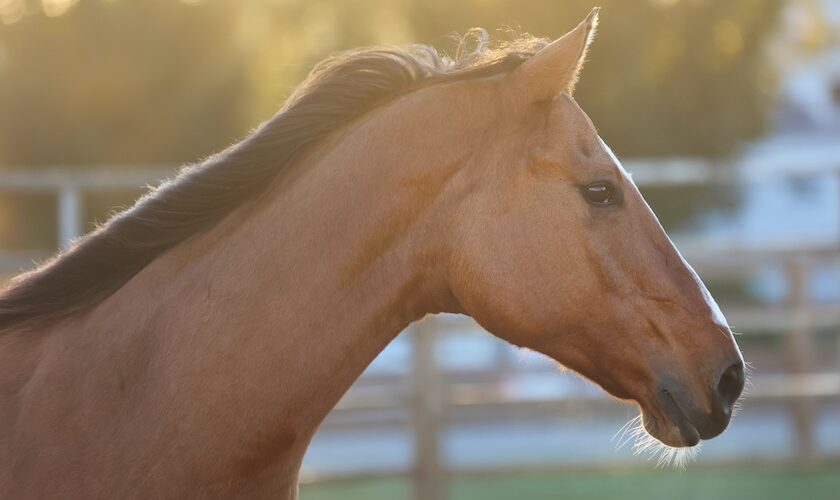
by Kristin Pitzer
When it comes to diseases in horses, pigeon fever is one that should win an award for most misleading name — it has no relation to pigeons, and fever isn’t usually associated with it. The disease is named for the abscesses that commonly form in the pectoral region of a sick horse, resembling a pigeon’s breast. But though its name is deceptive, pigeon fever is a common disease that affects many horses, especially those living in dry, arid parts of the country.
While not usually fatal, certain forms of pigeon fever can lead to complications and even death if left untreated. Quarter Horse News spoke with Dr. Jen Voellinger of Precision Equine in Springtown, Texas, to get more information on the cause, symptoms, treatment and prevention of this disease.
It May Be in Your Pasture
Pigeon fever is caused by the bacterium Corynebacterium pseudotuberculosis. It is common in places like California, Arizona, New Mexico and Texas, although new research suggests it may be present in most parts of the U.S., Southern Canada and Northern Mexico. The bacterium lives in the soil and is typically introduced to horses through breaks in the skin, often by flies dragging the bacteria into the wound.
Though not considered contagious between horses, flies may also spread the bacterium from a sick horse to healthy horses when they land in open wounds or bite. For this reason, affected horses should be separated from healthy horses if pigeon fever is suspected. This also prevents other horses from getting into the sick horse’s bodily fluids as the abscesses drain.
“If you’ve got a horse that’s draining lesions, I try to isolate that horse just because if flies land on those areas that are draining, they can spread it to different horses,” Voellinger said. “I also wouldn’t let a horse just nose a bunch of drainage. I try to pick up any pus and get rid of it the best I can to keep the flies off of it.”
Pigeon Fever Strikes Three Different Ways
The disease presents in three forms — external abscesses, internal abscesses and ulcerative lymphangitis — with external abscesses being the most common.

“The external abscesses are usually big abscesses, like the big breast abscesses they can get,” Voellinger said. “The internal abscesses can be anywhere — the lungs, spleen and liver are the most common ones. In the ulcerative lymphangitis form, it basically gets into the lymphatic system and will look like edema up and down the legs along with tiny, pea-sized abscesses and sores, commonly on the legs. I’ve seen them come up in other parts of the body, too. The lymphatic system goes everywhere, so they could be anywhere it goes.”
Most horses present with one form, but some, especially those that are immunocompromised, may be affected by all three. How your veterinarian treats it will depend on which form(s) your horse has.
Treatment Hinges on a Proper Diagnosis
Large abscesses, particularly in the chest, abdomen and limbs, are the obvious symptom of pigeon fever, but if your horse is lethargic, eating less, has developed an odd lameness or has swollen legs, your veterinarian may suggest an antibody test. For draining lesions, he or she can do a culture to look for the bacterium.
Veterinarians will typically let external abscesses develop and drain on their own. Most of these horses won’t even need antibiotics if they continue to improve and heal. Voellinger may put horses with the ulcerative lymphangitis form on antibiotics if they have leg swelling, edema and cellulitis. For those with internal abscesses, antibiotics are a must.
“You absolutely have to do antibiotics and probably for two to three months-plus on that, depending on the severity,” Voellinger said. “A lot of times you have to add Rifampin into that to help drive the antibiotic into the actual abscess. The good news is the bacteria is susceptible to most antibiotics, so it is pretty easy to kill if you can actually get the drug there. But it’s just hard to treat abscesses because they create a fibrous capsule around them, and it protects that bacteria from blood penetration, which is what you need to get your antibiotics there.”
Compromised Horses May Develop Complications
Horses with straightforward external abscesses may take some time to heal, but their prognosis is typically good. Those with internal abscesses, depending on how severe they are, generally have a good to guarded prognosis.
Horses that are immunocompromised for some reason, whether it’s because they’re older, have Cushing’s disease or have other metabolic diseases or autoimmune conditions, may struggle more to overcome the disease because their bodies don’t have the cellular capacity to fight off infection.
“All demographics are going to get exposed, but those horses are definitely going to be more susceptible,” Voellinger said. “Other populations seem to fight it off better and may not get clinical signs. Older horses that are more immunocompromised are going to be the ones that get the clinical signs more frequently or have worse cases.
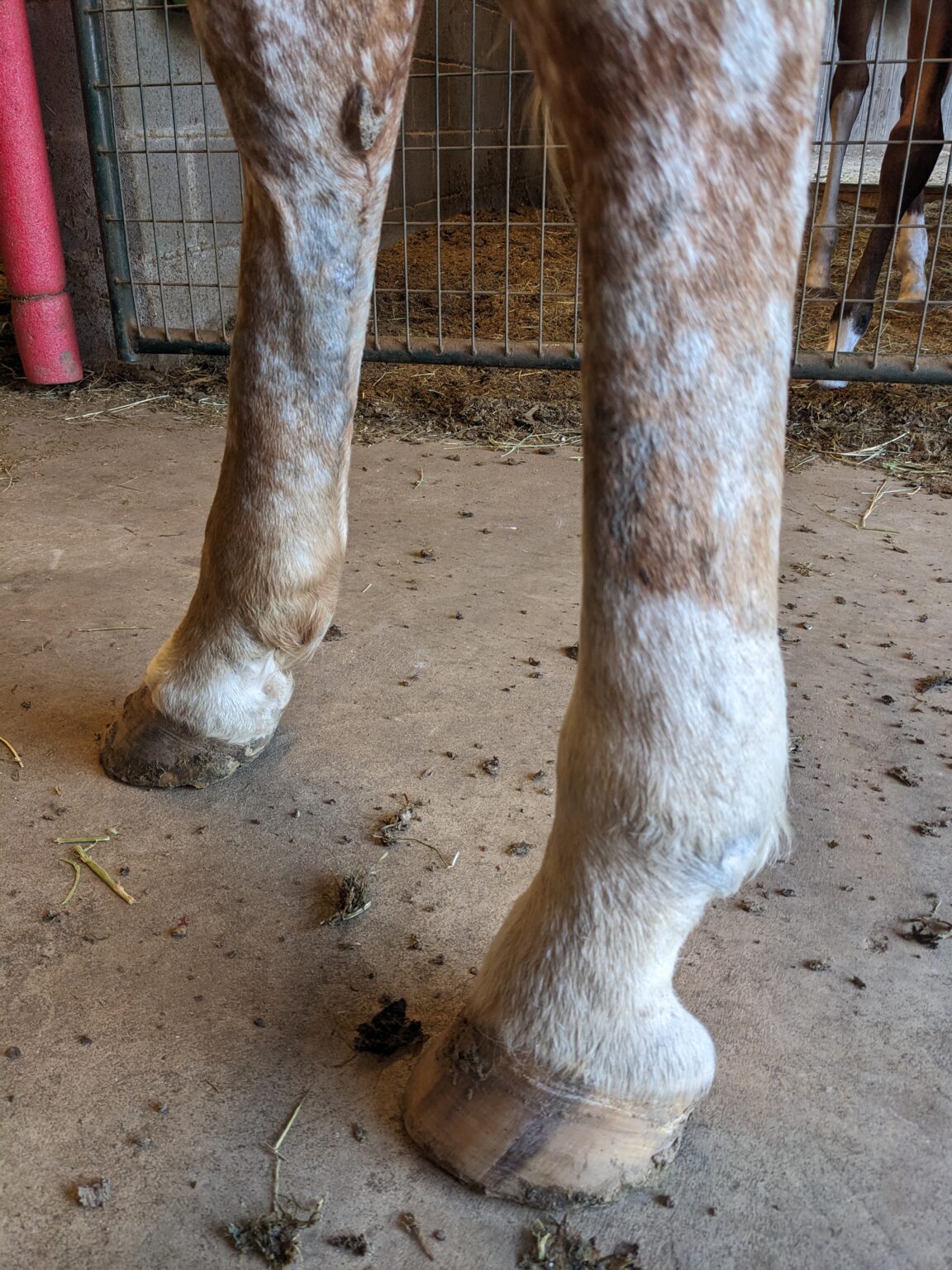
“It’s the same as why older people are more susceptible to flu and things like that,” Voellinger added. “Their body isn’t as robust and healthy to fight off infections. With Cushing’s, it messes up all the body systems and decreases immunity. They’re more prone to infections of all kinds.”
Reducing Flies Can Help Prevent the Spread
Because the bacteria lives in the soil, pigeon fever can be difficult to prevent. Many horses have likely already been exposed to it at some point in their lives, Voellinger said. Whether horses develop clinical symptoms or fight off the infection depends on each individual horse’s overall health and situation.
The best thing you can do to protect your horse is practice good fly control, she added. Reducing the fly load on your property gives flies less opportunities to introduce the bacterium to your horses.
“Fly sheets, fly sprays, IGR [insect growth regulator] feed-through fly treatments, fly systems in barns, fly predators — anything like that is really your best offense,” Voellinger said.
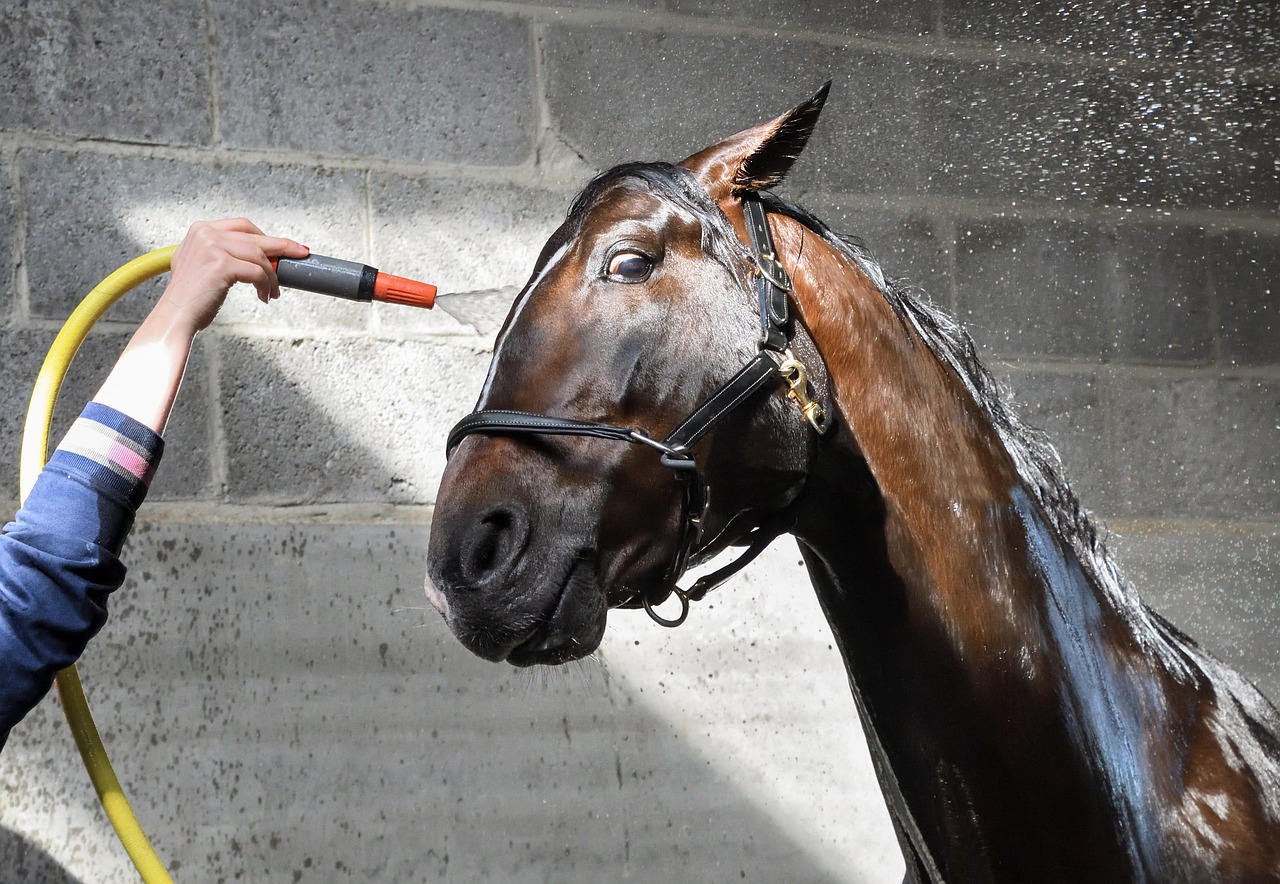
Yes, it has been a very hot summer for many of us. We still love to ride but of course our horse's health comes first - always.
To combat summer heat while riding horses, focus on reducing exertion, providing shade and water, and adjusting riding times to avoid the hottest parts of the day. Consider using cooling aids like misting systems and electrolyte supplements.
Here are some suggestions:
Riding Schedule and Intensity
- Ride During Cooler Hours:
Schedule rides for early mornings or late evenings when temperatures are lower. - Reduce Ride Duration and Intensity:
Shorten ride times and reduce the intensity of work, especially during peak heat hours. - Plan Cool-Downs:
Ensure a proper cool-down period after riding, including rinsing with cool water.
Providing Cooling Aids
- Shade: Provide access to shaded areas during turnout and breaks.
- Water: Ensure horses have access to plenty of fresh, cool water and electrolyte supplements.
- Ventilation: Use fans to improve airflow in stables, especially if horses are stalled during the day.
- Cooling Aids: Consider using cooling blankets, leg wraps, or specialized saddle pads to help regulate temperature.
- Misting Systems: Utilize misters to help horses cool down, especially after exercise.
Other Considerations
- Clipping:
Clip horses with long hair coats to help them shed heat more effectively. - Sun Protection:
Protect horses from sunburn, especially those with light skin or pink skin under white hair. - Observe for Heat Stress:
Monitor horses for signs of heat stress, such as excessive sweating, rapid breathing, or lethargy. - Consult with Veterinarian:
If you suspect your horse is suffering from heat stress, consult with a veterinarian immediately.
Don't forget to properly hydrate yourself too! You need to be well for your own health and the sake of your horse. Stay cool and enjoy!
You can find more informative articles in our section on Tack & Farm. Take a look at our Curated Amazon Store for our selections in a wide variety of categories!
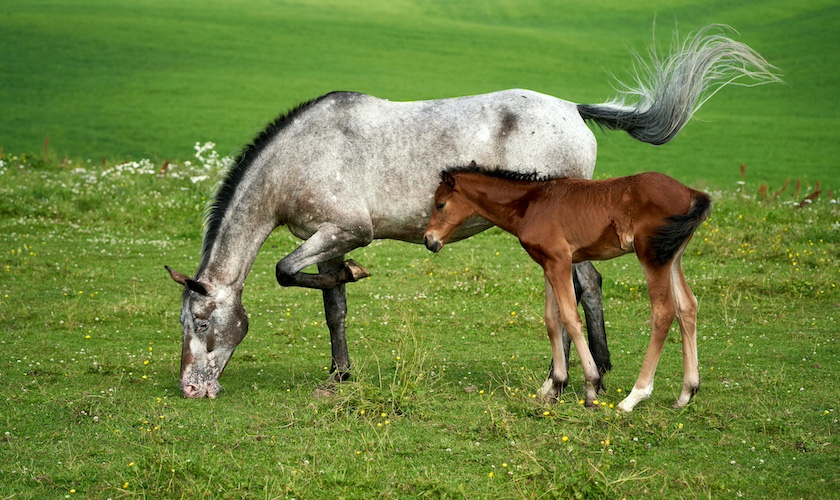
by Kristin Pitzer
With temps soaring into the 90s and above, humidity levels ramping up and insect activity increasing, there’s no doubt about it: the “dog days of summer” are here. The phrase refers to the 20 days before and after the star Sirius, or the “Dog Star,” rises and falls in conjunction with the sun and is typically used to describe the hottest and most humid days of summer.
Despite the often-unpleasant weather, many shows and events take place during this time. But as the temperature rises, the risk of heat stress in horses also increases, especially if they’re working vigorously. Quarter Horse News spoke with Jamie Pribyl, DVM, Professional Services Veterinarian at Boehringer Ingelheim, to learn how to ride and show safely during the hot days ahead.
Temperature and Humidity Play the Biggest Role
While there are several factors that can cause a horse to go into heat stress, temperature and humidity levels are the biggest. Once the temperature rises above 80 degrees, even without humidity, horses struggle to stay cool, especially if they’re in heavy work.
“And if our humidity is elevated, that’s going to add to it,” Pribyl said. “You can add the ambient temperature, so let’s say it’s 90 degrees, to the percent humidity, and if you get a number over 150, then we’re at a really high risk. At that point, the horse has a really difficult time cooling itself with its regular mechanisms.”
Other factors that contribute include being turned out in the sun with no shade; being shut into a poorly ventilated barn; standing in a trailer that is parked in the sun; and not having access to water.
Horses Need Help Acclimating
Horses that live in cooler parts of the country but travel to hotter locations for events may find themselves struggling with the heat even more than their peers. It takes a couple weeks for a horse to acclimate to a new environment, Pribyl noted. If you don’t have extra time for your horse to adjust, there are a few things you can do to help protect him.
“If you’re traveling during the summer to a hotter area, try to do your travel overnight because it’s cooler then,” Pribyl said. “Make frequent stops to give them some water, and if you’re providing them with electrolytes, make sure they also have plain water so that if they don’t like the electrolytes, they’ll drink the plain water instead.”
During the event, try to ride during the coolest parts of the day — mornings or evenings — and limit warmups to retain energy for the show pen. After your run, walk your horse out until their breathing has returned to a normal level, and offer them small amounts of water — half to one gallon every 15 to 20 minutes as you’re walking them out. You can also cold hose them continuously to help them cool, but if you stop while they’re still hot, make sure and scrape any insulating layers of water off to dissipate the heat.
Watch for These Signs
Horses that are suffering from heat stress may not exhibit obvious signs immediately. In fact, they might not look that different at first from a horse that has just been ridden or worked hard.
“If the horse is working, we’re used to seeing them sweat, but a horse in heat stress is going to be sweating excessively,” Pribyl said. ‘That respiratory rate’s going to kick up, and it’s not going to come down as quickly as we would expect it to if they’re being rested. Their heart rate is going to kick up as well. We might see lethargy or fatigue, and then sometimes we can see decreased appetite as well.”
If you don’t catch the early symptoms, a horse that is progressing into heat exhaustion may stop sweating entirely, a condition called anhidrosis. They will become severely dehydrated and may develop muscle tremors and weakness. If their symptoms continue to progress, their condition can become an emergency very quickly.
“The severe symptoms include a very high body temperature —if you were to take the rectal temperature, it could be over 103 or over 105. Basically, the cooling mechanisms have completely failed,” Pribyl said. “At that point, we’re going to see labored breathing. We could even see collapse or some neurologic symptoms like confusion and disorientation. They might develop colic symptoms, and we can start to see organ failure.”
Beware of Anhidrosis
Anhidrosis affects anywhere from 2% to 6% of horses, particularly those living in hot, humid climates. If you notice your horse has stopped sweating, stop all activity immediately. Get them to a cool, shaded area, take their temperature and start working to cool them down. Monitor them for signs of lethargy, reduced appetite and dehydration.
“If they have a temperature above 102 and they haven’t just been vigorously exercising, that’s a tip that this horse isn’t cooling itself,” Pribyl said. “Hose them with cold water, focusing on areas of the horse where the large blood vessels are located, so the neck and the legs. The whole body is great, but focus on those areas. Offer them water, give them electrolytes and monitor those vital signs.”
If your horse is suddenly experiencing anhidrosis when he never has before, call your veterinarian immediately.
Healthy Horses Handle Heat Better
If humans could control the weather, we’d likely never have to worry about heat stress again. But, since we can’t, the best thing you can do to protect your horse from overheating is to feed him properly, offer him plenty of water and shade, and keep him in shape for the type of riding and showing you enjoy.
One tool in your toolbox that is helpful in preventing heat stress is having your horse examined regularly by your veterinarian. He or she can help assess your horse’s body condition and alert you if your horse has a condition that makes him more susceptible to heat illnesses.
“If they’re overweight, that layer certainly insulates them, and that’s going to make it harder for them to cool,” Pribyl said. “Any horse that has PPID — so horses with Cushing’s disease — if they have excess long hair, they’re going to be more susceptible, especially in the summer months. What can we do? Have the overweight horse lose weight, and with the PPID horse, we could body clip them.
“It’s important to monitor all horses during extremely hot conditions, even if you aren’t competing,” Pribyl added. “If you ever suspect a problem, it’s best to call your veterinarian, as he or she knows your horse and can help determine appropriate next steps.”
This article originally appeared on Quarter Horse News and is published here with permission.
There are more informative and entertaining articles in our section on Tack & Farm. While you're here be sure to check out our Curated Amazon Store.
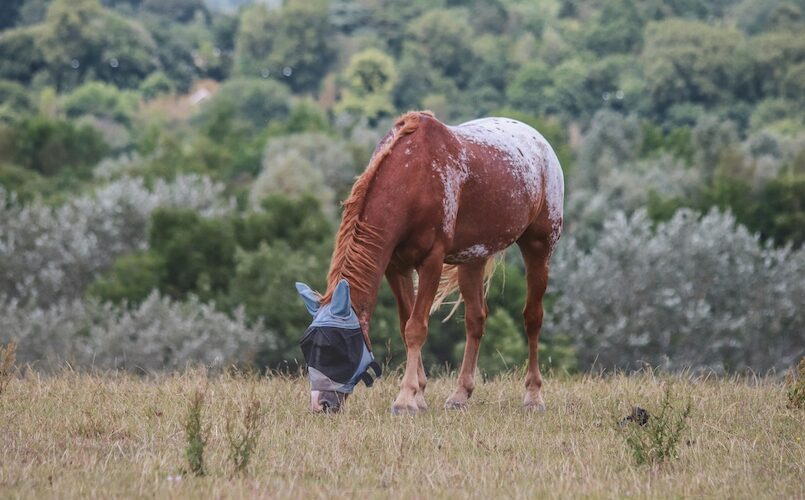
by Kristin Pitzer
As temperatures rise, vegetation flourishes and daylight hours lengthen, there’s no doubt about it: summer is on its way. Many riders enjoy the extra sunshine and longer days, but with warmer weather also arrives the bane of every horse owner’s existence: flies and mosquitoes.
These insects are known for their painful bites and general annoying behavior, but they are also the bearers of something much more sinister. Without proper control measures, flies and mosquitoes can transmit some of the deadliest diseases to your horse.
Quarter Horse News spoke with Dr. Amber Grimes of Carter Veterinary Services, located in Hardeeville, South Carolina, to get the low-down on fly- and mosquito-transmitted diseases and find out how to prevent these pests in the first place.
Flies Spread More Than You Think
A number of diseases and conditions are spread by flies. The most significant in the U.S. include Equine Infectious Anemia (EIA), summer sores, Vesicular stomatitis and sweet itch. Horses that live in pastures bordering creeks and rivers can also be susceptible to Potomac Horse Fever, and those located in the Southwestern U.S. and other dry, arid areas could be exposed to Pigeon fever. For the most part, none of these diseases, except for Potomac Horse Fever, are preventable by vaccines.
“Fly control is so important for these diseases because there is no other method of prevention,” Grimes said. “Preventing the fly from getting to the horse is crucial in preventing diseases that have major consequences and sometimes no treatment.”
The majority of fly diseases are treatable, but failing to treat them can lead to severe outcomes. For instance, Vesicular stomatitis, which is highly contagious and spreads through biting flies, causes ulcers and erosions on the mouth, tongue, coronary band, udder and sheath. Summer sores, or habronemiasis, are caused when flies deposit habronema larvae into open wounds or mucous membranes, producing an inflammatory reaction that leads to non-healing wounds. Even sweet itch, which is an allergic reaction to bites, can cause hair loss, sores, infection and weight loss.
EIA, on the other hand, is not treatable. Once a horse contracts it, it must either be humanely euthanized or spend the rest of its life in isolation at least 200 yards away from any other equine animals. To prevent EIA outbreaks, horses that leave their property for any reason must be accompanied by a current negative coggins test.
Prevention Is the Best Defense
To protect your horse from fly-borne illnesses, the best thing you can do is limit the number of flies on your property. It may sound impossible, but there are several different ways you can create a “no fly zone.”
“Fly masks, sheets and boots are very important because they provide a barrier to the flies to help prevent them from getting on the horse,” Grimes said. “The downside is that some horses don’t tolerate them and pull them off or tear them. Sprays like permectrin also help, but I feel like I always hear that they don’t last very long. Some people install misters that spray at certain times of the day to continually keep the horse covered when in a stall.”
Other fly-control methods include picking up manure from stalls and pastures twice a day at minimum; placing fans on stalls that blow flies off horses; hanging up sticky tape and traps; and applying topical products like Vectra 3D, a monthly flea and tick preventative for dogs that can repel ticks and flies on horses. You can also add a feed-through formula to your horse’s grain, which prevents flies from developing in manure, rather than killing adult flies. It must be fed continuously to all horses on the property, plus horses in neighboring pastures; otherwise, you won’t see much difference.
Mosquito-Borne Illnesses Are Deadly, but Preventable
There are only four significant mosquito-transmitted diseases in the United States, but the ones that are present — Eastern equine encephalomyelitis (EEE), Western equine encephalomyelitis (WEE), Venezuelan equine encephalomyelitis (VEE) and West Nile Virus (WNV) — are quite deadly, with inflammation of the brain being the main symptom.
At 90%, EEE and VEE have the highest mortality rates. EEE is spread when mosquitoes feed on infected birds and then bite horses. VEE, despite its name, is found in many places outside of Venezuela, including the Southern U.S. While its hosts tend to be rodents and birds, which spread the disease to horses through mosquito bites, infected horses can pass the disease to other horses via mosquitoes, too.
WEE is similar to EEE in how it is transmitted, but it has a lower mortality rate at 20% to 40%. Birds are also the natural host for WNV, which has a 35% mortality rate, but while most horses recover, many are left with long-term effects like behavioral and walking abnormalities.
These diseases are definitely alarming, but fortunately, there is good news. All four can be prevented by keeping your horse on a consistent vaccine schedule.
“Mosquito control is important, but vaccines are just as, if not more, important,” Grimes said. “In populations where mosquitoes are very prevalent, it is advisable to vaccinate twice a year to prevent disease from occurring. It is much easier to prevent than it is to treat, especially since none of these diseases have treatments.”
Even Vaccinated Horses Need Mosquito Control
Even if your horses are vaccinated, it’s wise to limit mosquito development on your property for your horses’ comfort and your own. Some of your fly-control measures, like fly boots and sheets, sprays, traps and fans, can help with this, but there are other methods you can employ for mosquitoes.
“Eliminate standing and stagnant water to remove their breeding ground, along with vegetation that could be their habitat,” Grimes said. “Clean your water troughs regularly, and if you have stalls that are completely indoors, you can keep your horses in during dawn and dusk when mosquitoes are most active. There are also natural repellants like garlic, apple cider vinegar and essential oils such as citronella and eucalyptus that are said to repel mosquitoes.”
Layer Your Defenses to Ensure Complete Protection
If you live in a region that is particularly prone to flies and mosquitoes, you may have to employ multiple methods to get some semblance of control. A barrier, like fly sheets, boots and masks is the first step, Grimes said, followed by good environmental practices.
“I believe that a combination of these things is of great benefit,” Grimes said. “Keep the property free of manure, use traps to get the adult flies and mosquitos, give feed-throughs to prevent more flies from maturing and spray repellants. Most importantly on the mosquito side is vaccinations. Vaccination is at the top of my list due to its ability to prevent mosquito diseases. Twice a year vaccination in heavy mosquito populated environments is highly recommended.”
Preventing these diseases is often easier than treating them, so if you don’t already have control practices in place, it’s a good idea to start now. You likely won’t eliminate every fly and mosquito on your property, but by taking preventative measures, you can limit the number that come into contact with your horse. That way, you’ll be able to spend more time riding and enjoying the long summer days ahead.
This article originally appeared on Quarter Horse News and is published here with permission.
There are more informative and entertaining articles in our section on Tack & Farm. While you're here be sure to check out our Curated Amazon Store.
- Five Tips for Purchasing a Used Saddle
- Five Tips to Choose the Right Tractor for a Small Horse Property
- 7 Ways to Improve Your Horse's Performance with the Right Equipment
- Leather Saddlebag Shoulder Bags (51:45)
- Leather Texture Techniques (7:26) - Weaver Leather
- 17 Different Types of Saddles (When to Use Which One)
- Snow Horseshoe?? Diseased Hoof | Therapeutic Horseshoeing | Satisfying Farrier (13:31)
- Tall vs. Short Boots: What’s Best for Equestrians?
- Overcoming a Horse Trailer Accident: Cowgirl Shares Hope
- The Leather Element: Rare Tools - Weaver Leathers (8:53)
Our Mission — Serving the professional horse person, amateur owners, occasional enthusiasts and sporting interests alike, the goal is to serve all disciplines – which often act independently yet have common needs and values.
Equine Info Exchange is totally comprehensive, supplying visitors with a world wide view and repository of information for every aspect related to horses. EIE provides the ability to search breeds, riding disciplines, horse sports, health, vacations, art, lifestyles…and so much more.
EIE strives to achieve as a source for content and education, as well as a transparent venue to share thoughts, ideas, and solutions. This responsibility also includes horse welfare, rescue and retirement, addressing the needs and concerns of all horse lovers around the world. We are proud to be a woman-owned business.
































